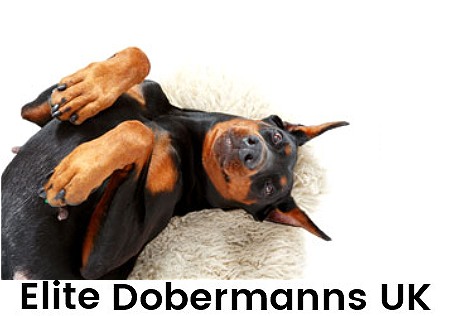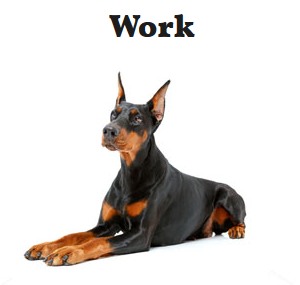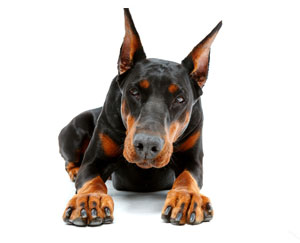Crop & Dock

Ear cropping and tail docking
Dobermans are born with floppy ears and long tails, similar to a Cocker Spaniel or Labrador. The ears are cropped and tails docked in order that they achieve the upright standing ear position and short tail. There can be a lot of disagreement regarding this topic so we want to be as forthright and open as possible.
It is prudent for all Doberman owners and prospective owners to be fully educated on this subject in order that they are able to make the best choice for their dog and so that they can educate others that comment (people always ask questions when they see a cropped and docked Doberman or a puppy with tape on its ears).
Some people are attempting to remove our right to make choices and therefore ban all cropping and docking. Please read and do the research for yourself. Don’t just assume it is cruel or think it looks better so it must be better. Some countries do not legally allow these practices (such as the UK) but that does not mean they are unethical. Many of those same countries have exceptions to allow cropping and docking on dogs meant to do working sport/competition such as IPO or Schutzhund.
In the UK the only way to legally own a Doberman with cropped ears and a docked tail is to import the dog from overseas with the tail and ears already cropped and docked. These procedures must have been performed by a veterinarian in a qualifying country that allows cropping and docking.
The Doberman is the only breed, bred for personal protection. This is their true nature – to always be protecting and “working” whether they are active in competition or not. It is down to this and the following reasons that we fully endorse cropping and docking when performed ethically by a skilled professional with the requisite after care.
Appearance
The look between the cropped and the un-cropped Doberman is vastly different. Our cropped Dobermans have a more alert and striking look. Dobermans with floppy un-cropped ears have more the look of a hound with Doberman markings. If we compare the responses of people to our cropped and docked Dobermans to un-cropped, we usually hear things like, “brave and strong” compared to “pretty and cute” respectively. In a dog that is meant to be a protector we believe that the first impression if of the utmost importance
Puppies can look pretty cute with those floppy ears but as they mature it is likely the ear set will change. Some settings can result in complimentary style, but often there is no way to be certain or predict what type of ear setting may result in a particular adult dog.

Often the ear set will result in long hanging ears that droop which detracts from the look of the chiselled, wedge shaped head. The first thing that comes to mind may be “what a cute and goofy dog,” which may fit the personality, but is not what is desired for the impression of the breed.
The Doberman breed is designed to protect. One of the greatest security measures is simply the appearance of our Dobermans. Many can hardly recognise a Doberman with un-cropped ears and an un-docked tail. The look for the breed is meant to be regal, also described as “the look of a champion”. This look is hardly achieved with un-cropped ears and an un-docked tail.
Protection work/functionality

Let us consider for a moment the more practical side of things. When dogs play with each other they go for the ears. When a human or opponent goes after a dog, the ears make great “handles”. The ears can be grabbed, bitten or torn and if they are it can be very painful for the dog. This is why in a protection bred dog, the ears can be a huge liability. If the ears are caught torn or pulled hard enough this will cause your Doberman a great deal of injury and discomfort. Your veterinarian may need to repair them with surgery and give your dog antibiotics to prevent infection. The ears are likely to scar and the healing could result in an unsightly shaping of the ear.
This is the exact reason why tails are docked as well. Dobermans tail are particularly thin and susceptible to painful breaking or damage just from every day wear and use. Docking the tail prevents serious injury and damage from arising in the first instance. Before you think, “we only want our Doberman as a pet, we don’t plan on pursuing protection training or unruly play with other dogs and I live in a safe area”, remember – our Dobermans are always on watch. A client of ours had one of our Dobermans as a family pet, she had an intruder enter her property in the middle of the night and as it should do, her Doberman confronted and chased away her attacker. Our point is this, protection is an instinct genetically imprinted onto our dogs. Whether you intend to train your dog in IPO or Schutzhund or not, our dogs will always be on the lookout. It is a liability and disservice in our opinion to leave them un-cropped when it is their nature to act for you.
Doberman health
Un-cropped Dobermans can also suffer from ear infections. Dobermans are susceptible to inner ear infection with un-cropped ears due to the restricted air flow the ear receives. Areas with a high degree of humidity or moisture are more prone to infection.

Bacteria, mites, and ticks seek out dark moist and warm environments, the perfect home for these undesirables would be the inner canal of your Doberman covered by an un-cropped ear. These infections are painful and can lead to hearing loss or even ruptured inner ears. The cropped ear helps to allow more airflow and light in which not only reduces or eliminates ear infection, but some studies show it intensifies their hearing as well.
About Ears
To crop or not to crop

In nature there is no canine or animal that has naturally occurring floppy ears that close off the ear canal. The definition of natural is, “existing in or caused by nature; not made or caused by humankind.” Look at the wolf hyena and fox – you will consistently see that mother nature has adapted these animals in the wild to have upright ears, or if the ears do come downward they are not closing off the canal in such a way that the human bred, breeds of dogs of today do.
Un-cropped ears are often referred to as “natural” but that does not mean it is actually natural. Look at the English Bulldog for example, not being able to mate or give birth without some form of human assistance. If we used the natural logic, this breed would be eliminated because it would not be “natural” for us humans to assist or alter the way they are.
How do they do it?
The ethical method of cropping is an art done by a licensed, skilled, and experienced veterinarian in a qualifying country. The ideal age for a Doberman is 7-9 weeks of age, before the ear cartilage begins hardening.
We have observed the cropping ourselves and it is very simple. The veterinarian will have a pre-surgery consultation where they discuss the style of cropping desired and verify the VWD status. They are sedated, laser cropped, and the edges are stitched up. The surgery itself is very brief and the puppies wake up very quickly, when they do they are hungry and playing like usual. They will have a cup on their head and need a little cream applied on the edges while the crop heals. During this time, they play just as rough if not more because the cone/cup on the head looks like a very fun chew toy! The stitches are removed at about a week and the cup comes off at about two weeks. Not any part of this process is cruel or painful, in fact we believe that it is in our puppies’ best interest. After the cup comes off the ears will need to be posted for several weeks depending on the dog and the style and length of the crop (there are videos showing how to do this in the, “links” section of our website). The ears sometimes do not automatically stand straight although with posting in time the cartilage hardens upright. Cropped ears still retain mobility and you will see them flattening them or perking them to the right or left.
